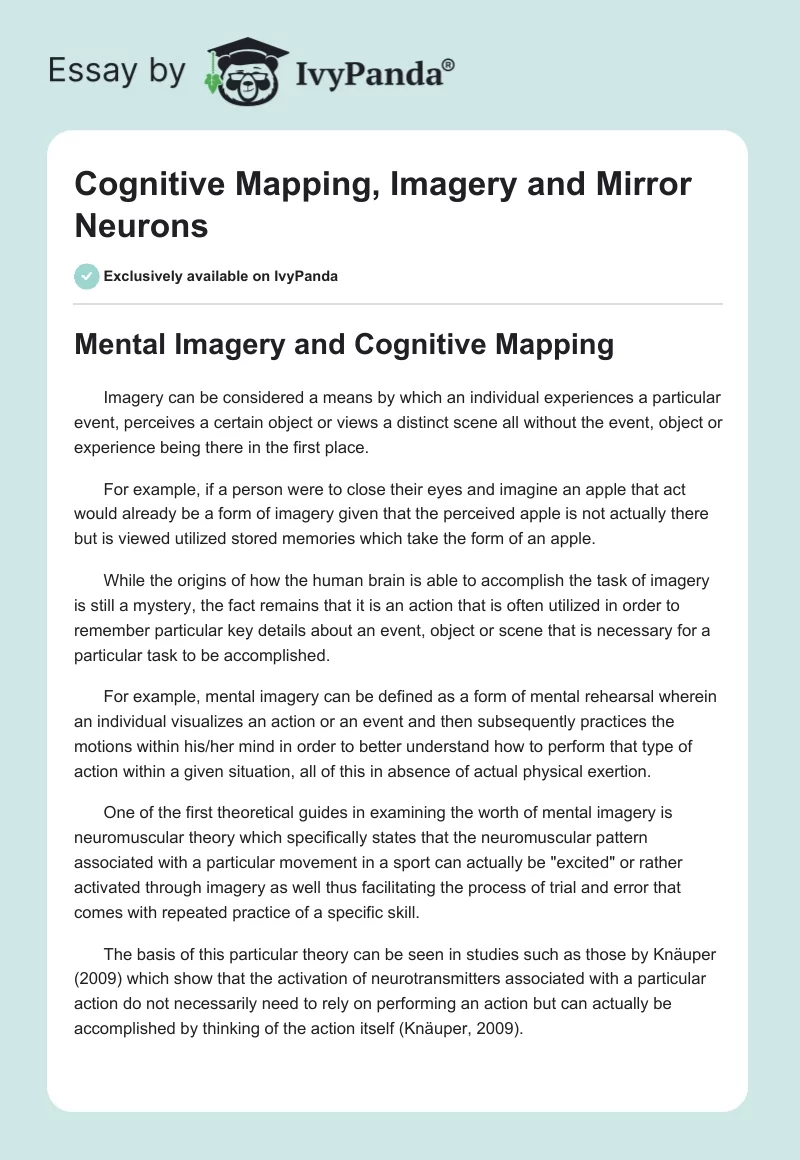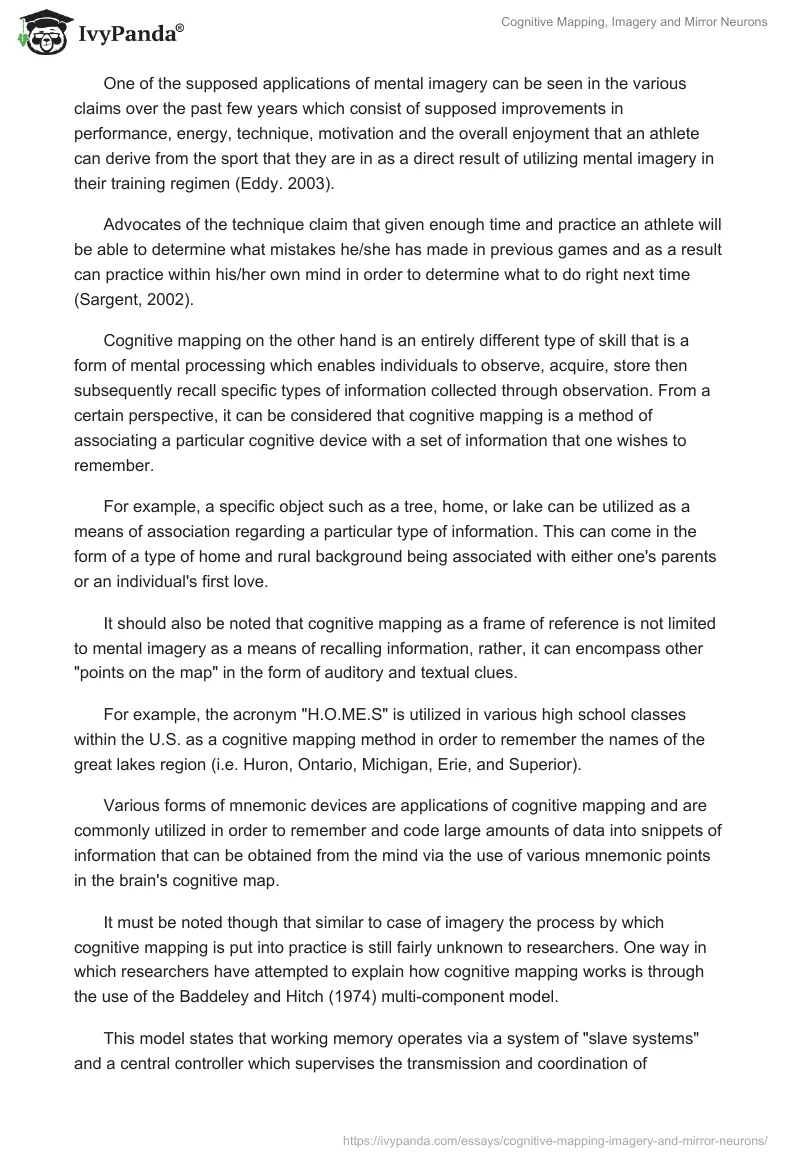Mental Imagery and Cognitive Mapping
Imagery can be considered a means by which an individual experiences a particular event, perceives a certain object or views a distinct scene all without the event, object or experience being there in the first place.
For example, if a person were to close their eyes and imagine an apple that act would already be a form of imagery given that the perceived apple is not actually there but is viewed utilized stored memories which take the form of an apple.
While the origins of how the human brain is able to accomplish the task of imagery is still a mystery, the fact remains that it is an action that is often utilized in order to remember particular key details about an event, object or scene that is necessary for a particular task to be accomplished.
For example, mental imagery can be defined as a form of mental rehearsal wherein an individual visualizes an action or an event and then subsequently practices the motions within his/her mind in order to better understand how to perform that type of action within a given situation, all of this in absence of actual physical exertion.
One of the first theoretical guides in examining the worth of mental imagery is neuromuscular theory which specifically states that the neuromuscular pattern associated with a particular movement in a sport can actually be “excited” or rather activated through imagery as well thus facilitating the process of trial and error that comes with repeated practice of a specific skill.
The basis of this particular theory can be seen in studies such as those by Knäuper (2009) which show that the activation of neurotransmitters associated with a particular action do not necessarily need to rely on performing an action but can actually be accomplished by thinking of the action itself (Knäuper, 2009).
One of the supposed applications of mental imagery can be seen in the various claims over the past few years which consist of supposed improvements in performance, energy, technique, motivation and the overall enjoyment that an athlete can derive from the sport that they are in as a direct result of utilizing mental imagery in their training regimen (Eddy. 2003).
Advocates of the technique claim that given enough time and practice an athlete will be able to determine what mistakes he/she has made in previous games and as a result can practice within his/her own mind in order to determine what to do right next time (Sargent, 2002).
Cognitive mapping on the other hand is an entirely different type of skill that is a form of mental processing which enables individuals to observe, acquire, store then subsequently recall specific types of information collected through observation. From a certain perspective, it can be considered that cognitive mapping is a method of associating a particular cognitive device with a set of information that one wishes to remember.
For example, a specific object such as a tree, home, or lake can be utilized as a means of association regarding a particular type of information. This can come in the form of a type of home and rural background being associated with either one’s parents or an individual’s first love.
It should also be noted that cognitive mapping as a frame of reference is not limited to mental imagery as a means of recalling information, rather, it can encompass other “points on the map” in the form of auditory and textual clues.
For example, the acronym “H.O.ME.S” is utilized in various high school classes within the U.S. as a cognitive mapping method in order to remember the names of the great lakes region (i.e. Huron, Ontario, Michigan, Erie, and Superior).
Various forms of mnemonic devices are applications of cognitive mapping and are commonly utilized in order to remember and code large amounts of data into snippets of information that can be obtained from the mind via the use of various mnemonic points in the brain’s cognitive map.
It must be noted though that similar to case of imagery the process by which cognitive mapping is put into practice is still fairly unknown to researchers. One way in which researchers have attempted to explain how cognitive mapping works is through the use of the Baddeley and Hitch (1974) multi-component model.
This model states that working memory operates via a system of “slave systems” and a central controller which supervises the transmission and coordination of information (RepovŠ & Baddeley, 2006). The first “slave system” of the Baddeley and Hitch (1974) model is called the phonological loop which stores the sound of language.
This system operates via a method of continuous repetition where in order to prevent the decay of accumulated words, phrases, meanings etc. the system continuously repeats the content thus refreshing it and ensuring that a person doesn’t forget it. For example, remembering people’s names, numbers and associated information regarding a particular individual is governed by this system (RepovŠ & Baddeley, 2006).
The second “slave system” is called the visual-spatial sketchpad which is involved in the storage and retrieval of visual and spatial information. Through the Baddeley and Hitch (1974) multi-component model, a cognitive map is supposedly created as a byproduct of the slave systems wherein specific parts of the system are utilized to gather information from other parts.
For example, visual and spatial data from one part of the system which is within an individual’s short term memory is utilized in order to access various aspects of their long term memory. Thus, a type of “map” is created based off of specific slave sections that have particular points that lead to the necessary memories that an individual is trying to draw from.
It should be noted though that this is merely one of the many ways in which cognitive maps have been interpreted and may not necessarily reflect what actually occurs since it is still a theoretical means of explaining how cognitive maps actually function.
Utilizing Cognitive Mapping and Imagery
Cognitive mapping and imagery can be applied as a means of improving long term memory by making it more easily accessible and brought to the forefront of one’s mind.
Based on the study of Poeppel (2012) it is actually assumed that the mind is able to remember a vast amount of knowledge extending as far back as several decades, however, such knowledge is often repressed by the mind in order to prevent an individual from being overwhelmed with the amount of information in it (Poeppel, 2012).
For example, if a person forgets a particular detail about a house on February 1st then remembers it on June 27th this information did not come out of nowhere; rather, it was still stored within that individuals memory and merely lacked the necessary cognitive “trigger” in order to bring it out.
This is where cognitive mapping and imaging come into the picture; by utilizing such aspects it is actually possible to improve long term memory by selectively adding particular cognitive points in the form of visual cues in order to remember particular details. By doing so this enables the mind to more easily access memories even if they were several decades in the past which as a result would improve a person’s long term memory.
The first model which attempts to explain how working memory functions is the Ericsson and Kintsch (1995) model which explains that all individuals utilize skilled memory in everyday tasks however most these memories are stored in long term memory and then subsequently retrieved through various forms of retrieval mechanisms (Gobet, 2000).
As such, it is necessary to have some form of retrieval mechanism, in this case cognitive mapping and imagery, in order to act as a means of effective memory retrieval.
Mirror Neurons
Various studies have stated that mirror neurons are a type of neuron that fires in instances where a person performs a particular action as well as when a similar action is accomplished by another individual, hence the term “mirror” (Bonaiuto & Arbib, 2010).
Since this particular neuron, as well as its various systems, fires based on personal and perceived action, various researchers investigating cognitive neuroscience and psychology hypothesize that mirror neurons are actually a means by which people learn particular skills through observation and imitation (Agnew et al., 2012).
It is actually speculated that systems of mirror neurons within the brain actually simulate perceived actions and is one of the primary means by which people learn (Tessitore et al., 2010).
For example, the study of British neuroscientist Adian Owen was able to correlate specific actions that were performed in the past by an individual with a particular neural firing pattern in the brain that occurred within the somatosensory cortex or even in the inferior parietal cortex.
This study was done through the use of a patient named Scott Routley who was in persistent vegetative state as a direct result of a car accident he was in 12 years ago. In his study, Own was able to determine that specific mirror neuron firing patterns can be attributed to certain actions and in particular regions of the brain.
For example, remembering the act of walking actually fired mirror neurons within the somatosensory cortex while the act of playing tennis showed a distinct degree of firing within the inferior parietal cortex. Owen explains that for each unique type of physical activity there is a specific region in the brain and a particular type of mirror neuron firing pattern that occurred.
It was at this point that Owen utilized an FMRI machine in order to determine whether Routley who was in a persistent vegetative state could utilize memories of particular actions in order to fire the necessary mirror neurons that hold the information on such actions.
The results of the experiment showed that Owen was able to answer yes or no questions despite not being able to speak by remembering specific actions that activate the necessary mirror neuron firing patterns in different areas of the brain (i.e. walking for yes, tennis for no).
It was based on this study by Adian Owens that it can be seen that mirror neurons associated with particular actions can be utilized as a means of mapping the cognitive function of the brain when it comes to specific physical actions.
Reference List
Agnew, Z. K., Wise, R. S., & Leech, R. (2012). Dissociating Object Directed and Non- Object Directed Action in the Human Mirror System; Implications for Theories of Motor Simulation. Plos ONE, 7(4), 1-9.
Bonaiuto, J., & Arbib, M. (2010). Extending the mirror neuron system model, II: what did I just do? A new role for mirror neurons. Biological Cybernetics, 102(4), 341-359
Eddy, K. D. (2003). Mental Imagery in Athletes With Visual Impairments. Adapted Physical Activity Quarterly, 20(4), 347.
Gobet, F. (2000). Retrieval structures and schemata: A brief reply to Ericsson and Kintsch. British Journal Of Psychology, 91(4), 591.
Knäuper, B. H. (2009). Using Mental Imagery to Enhance the Effectiveness of Implementation Intentions. Current Psychology, 28(3), 181.
Poeppel, D. (2012). The maps problem and the mapping problem: Two challenges for a cognitive neuroscience of speech and language. Cognitive Neuropsychology, 29(1/2), 34-55
RepovŠ, G. G., & Baddeley, A. A. (2006). The multi-component model of working memory: Explorations in experimental cognitive psychology. Neuroscience, 139(1), 5-21.
Sargent, G. (2002). The power of Mental Imagery. Sports Coach, 25(2), 18.
Tessitore, G., Prevete, R., Catanzariti, E., & Tamburrini, G. (2010). From motor to sensory processing in mirror neuron computational modelling. Biological Cybernetics, 103(6), 471-485.


